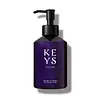What's inside
What's inside
 Key Ingredients
Key Ingredients

No key ingredients
 Benefits
Benefits

 Concerns
Concerns

 Ingredients Side-by-side
Ingredients Side-by-side

Water
Skin ConditioningSodium Methyl Cocoyl Taurate
CleansingSodium Cocoyl Alaninate
Cocamidopropyl Betaine
CleansingGlycerin
HumectantButylene Glycol Laurate
EmollientPEG-150 Distearate
EmulsifyingHoney
HumectantChamomilla Recutita Flower Extract
MaskingCurcuma Longa Root Extract
MaskingPEG-150 Stearate
PEG-120 Methyl Glucose Triisostearate
Butylene Glycol
HumectantPEG-4
HumectantPolysorbate 20
EmulsifyingCoceth-7
EmulsifyingPPG-1-PEG-9 Lauryl Glycol Ether
EmulsifyingPEG-40 Hydrogenated Castor Oil
Emulsifying1,2-Hexanediol
Skin ConditioningCaprylhydroxamic Acid
Stearic Acid
CleansingPEG-150
HumectantPropanediol
SolventCaramel
Cosmetic ColorantCitric Acid
BufferingHydroxyacetophenone
AntioxidantPhenoxyethanol
PreservativeEthylhexylglycerin
Skin ConditioningParfum
MaskingChamomilla Recutita Oil
MaskingWater, Sodium Methyl Cocoyl Taurate, Sodium Cocoyl Alaninate, Cocamidopropyl Betaine, Glycerin, Butylene Glycol Laurate, PEG-150 Distearate, Honey, Chamomilla Recutita Flower Extract, Curcuma Longa Root Extract, PEG-150 Stearate, PEG-120 Methyl Glucose Triisostearate, Butylene Glycol, PEG-4, Polysorbate 20, Coceth-7, PPG-1-PEG-9 Lauryl Glycol Ether, PEG-40 Hydrogenated Castor Oil, 1,2-Hexanediol, Caprylhydroxamic Acid, Stearic Acid, PEG-150, Propanediol, Caramel, Citric Acid, Hydroxyacetophenone, Phenoxyethanol, Ethylhexylglycerin, Parfum, Chamomilla Recutita Oil
Water
Skin ConditioningGlycerin
HumectantGlyceryl Stearate Se
EmulsifyingHelianthus Annuus Seed Oil
EmollientPropanediol
SolventSolanum Tuberosum Pulp Extract
SmoothingCaprylyl/Capryl Glucoside
CleansingGlycolipids
Skin ConditioningPhenoxyethanol
PreservativeOlive Oil Polyglyceryl-6 Esters
EmollientCarrageenan
Polyglyceryl-6 Pentaoleate
EmulsifyingLimnanthes Alba Seed Oil
Skin ConditioningPrunus Armeniaca Kernel Oil
MaskingPotassium Sorbate
PreservativeMenthyl Ethylamido Oxalate
Skin ConditioningEthylhexylglycerin
Skin ConditioningHippophae Rhamnoides Seed Oil
Skin ProtectingGlucose
HumectantFurcellaria Lumbricalis Extract
Skin ConditioningBromelain
Skin ConditioningCitric Acid
BufferingPapain
Skin ConditioningPrunus Amygdalus Dulcis Oil
Skin ConditioningLavandula Angustifolia Oil
MaskingCymbopogon Martini Oil
MaskingOrmenis Multicaulis Oil
MaskingPelargonium Graveolens Flower Oil
MaskingCitronellol
PerfumingAnthemis Nobilis Flower Oil
MaskingRosa Damascena Flower Oil
MaskingWater, Glycerin, Glyceryl Stearate Se, Helianthus Annuus Seed Oil, Propanediol, Solanum Tuberosum Pulp Extract, Caprylyl/Capryl Glucoside, Glycolipids, Phenoxyethanol, Olive Oil Polyglyceryl-6 Esters, Carrageenan, Polyglyceryl-6 Pentaoleate, Limnanthes Alba Seed Oil, Prunus Armeniaca Kernel Oil, Potassium Sorbate, Menthyl Ethylamido Oxalate, Ethylhexylglycerin, Hippophae Rhamnoides Seed Oil, Glucose, Furcellaria Lumbricalis Extract, Bromelain, Citric Acid, Papain, Prunus Amygdalus Dulcis Oil, Lavandula Angustifolia Oil, Cymbopogon Martini Oil, Ormenis Multicaulis Oil, Pelargonium Graveolens Flower Oil, Citronellol, Anthemis Nobilis Flower Oil, Rosa Damascena Flower Oil
 Reviews
Reviews

Ingredients Explained
These ingredients are found in both products.
Ingredients higher up in an ingredient list are typically present in a larger amount.
Citric Acid is an alpha hydroxy acid (AHA) naturally found in citrus fruits like oranges, lemons, and limes.
Like other AHAs, citric acid can exfoliate skin by breaking down the bonds that hold dead skin cells together. This helps reveal smoother and brighter skin underneath.
However, this exfoliating effect only happens at high concentrations (20%) which can be hard to find in cosmetic products.
Due to this, citric acid is usually included in small amounts as a pH adjuster. This helps keep products slightly more acidic and compatible with skin's natural pH.
In skincare formulas, citric acid can:
While it can provide some skin benefits, research shows lactic acid and glycolic acid are generally more effective and less irritating exfoliants.
Most citric acid used in skincare today is made by fermenting sugars (usually from molasses). This synthetic version is identical to the natural citrus form but easier to stabilize and use in formulations.
Read more about some other popular AHA's here:
Learn more about Citric AcidEthylhexylglycerin (we can't pronounce this either) is commonly used as a preservative and skin softener. It is derived from glyceryl.
You might see Ethylhexylglycerin often paired with other preservatives such as phenoxyethanol. Ethylhexylglycerin has been found to increase the effectiveness of these other preservatives.
Glycerin is already naturally found in your skin. It helps moisturize and protect your skin.
A study from 2016 found glycerin to be more effective as a humectant than AHAs and hyaluronic acid.
As a humectant, it helps the skin stay hydrated by pulling moisture to your skin. The low molecular weight of glycerin allows it to pull moisture into the deeper layers of your skin.
Hydrated skin improves your skin barrier; Your skin barrier helps protect against irritants and bacteria.
Glycerin has also been found to have antimicrobial and antiviral properties. Due to these properties, glycerin is often used in wound and burn treatments.
In cosmetics, glycerin is usually derived from plants such as soybean or palm. However, it can also be sourced from animals, such as tallow or animal fat.
This ingredient is organic, colorless, odorless, and non-toxic.
Glycerin is the name for this ingredient in American English. British English uses Glycerol/Glycerine.
Learn more about GlycerinPhenoxyethanol is a preservative that has germicide, antimicrobial, and aromatic properties. Studies show that phenoxyethanol can prevent microbial growth. By itself, it has a scent that is similar to that of a rose.
It's often used in formulations along with Caprylyl Glycol to preserve the shelf life of products.
Propanediol is an all-star ingredient. It softens, hydrates, and smooths the skin.
It’s often used to:
Propanediol is not likely to cause sensitivity and considered safe to use. It is derived from corn or petroleum with a clear color and no scent.
Learn more about PropanediolWater. It's the most common cosmetic ingredient of all. You'll usually see it at the top of ingredient lists, meaning that it makes up the largest part of the product.
So why is it so popular? Water most often acts as a solvent - this means that it helps dissolve other ingredients into the formulation.
You'll also recognize water as that liquid we all need to stay alive. If you see this, drink a glass of water. Stay hydrated!
Learn more about Water